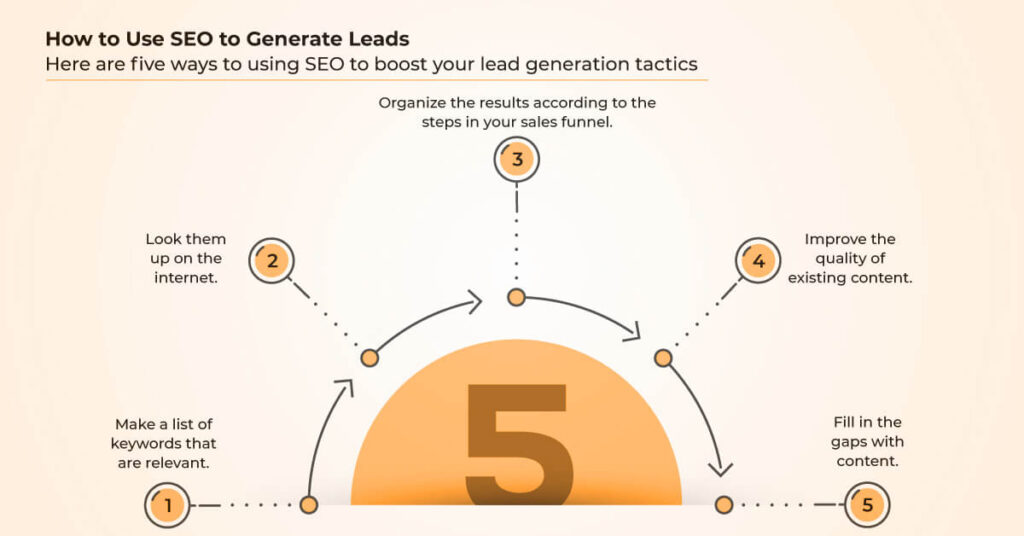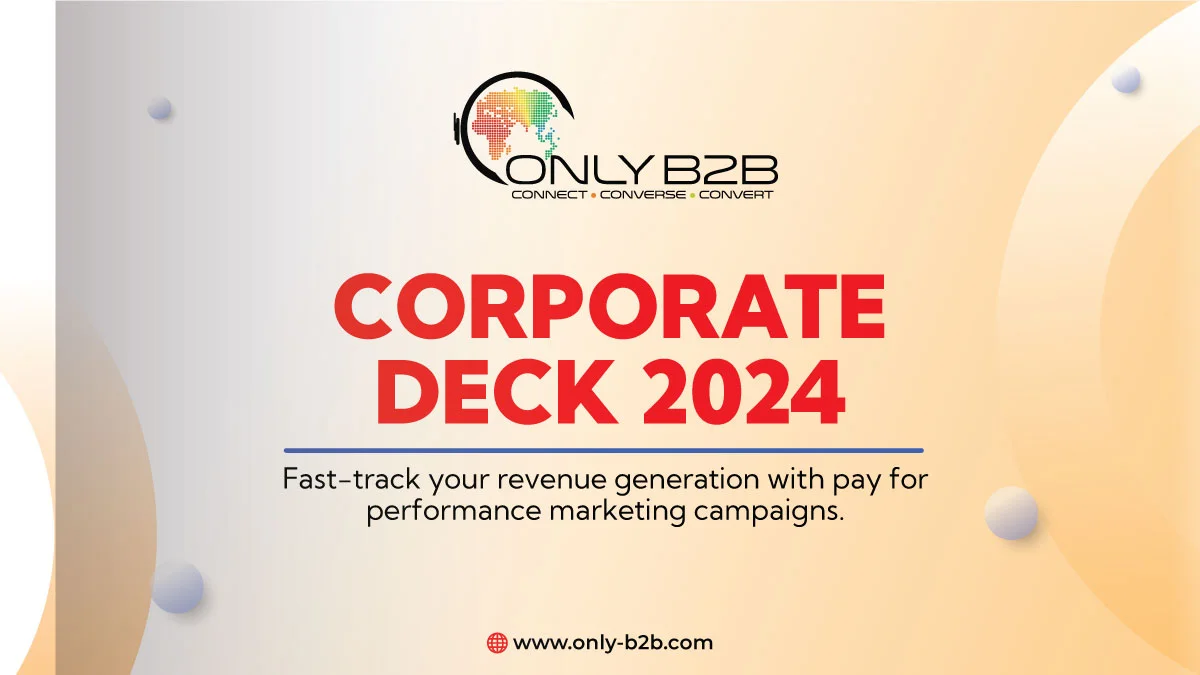
Too many marketing efforts still take place in cages, and one of the most secluded is search engine optimization (SEO). While most B2B firms rely on SEO and lead generation to generate new leads, these teams rarely communicate until new content requires an SEO analysis.
The general consensus appears to be that SEO assists a website—and all of its content—get discovered online, which creates leads in the grand picture, but lead generation is an entirely other set of operations aimed solely at acquiring new leads.
If done right, SEO can drive a 14.6% conversion rate. SEO is geared on attracting people who are actively looking for information about products or services, making it an effective lead generation strategy. SEO statistics show that leads generated as a consequence of search engine optimization have a 14.6 % conversion rate on average. Traditional techniques such as print advertisements and direct mail, on the other hand, have an average conversion rate of 1.7 percent.
A dynamic marketplace, on the other hand, is putting new demands on how marketers (and sales agents, and…just about every other component of a company) interact with their target audiences. Lead generation tactics are changing to match new expectations, but one aspect that is still absent from most playbooks might be the one that makes the most difference: SEO.
Audience Intent Research is Required in Today’s SEO Strategies
Table of Contents
The foundation for integrating SEO and lead generation strategies starts with a modern understanding of SEO, especially a notion known as “user intent.” User intent is the true definition behind the keywords people write in a search engine text box.
User intent may be divided into two categories:
Inform: When someone is seeking to discover about a topic.
Purchase: When someone is purchasing something described by the keyword.
It’s as easy as Googling your keywords to figure out what your audience truly means when they use them. The top-ranking sites for a keyword show the sort of material that people are seeking for the most when looking for that term. What evidence do we have? Because Google is committed to giving the greatest possible user experience, and its algorithms are working 24 hours a day, seven days a week to decode the purpose behind each search word.
For example, if you search for “email marketing,” you’ll largely see marketing software vendors attempting to promote their platforms. In other words, most individuals who search for “email marketing” are looking to buy something. They wish to purchase software. The word “marketing automation” has a wide range of meanings. The majority of the results on Page 1 are definitions and basic information regarding marketing automation. People are on the lookout for that data.
This is helpful info for every aspect of your SEO effort. You may direct customers to information that matches their requirements if you know what they’re looking for. For example, a company offering email marketing should ensure that their content contains a good product page that targets “email marketing” and associated keywords, depending on the information provided. On the other hand, a company selling marketing automation should concentrate on producing high-quality, useful content for that keyword.
Must Read: How To Embed Content Marketing And SEO For More Traffic And Leads?
B2B Lead Generation Needs User Intent Research
Buyers are self-educating deeper down the sales funnel than ever before, therefore lead generation requires user intent research. They’re uninterested with your meticulously built buyer’s journey model, entering it whenever they want and moving through it at their own time.
Most marketers are aware of this and are adjusting their lead generation techniques to meet changing trends and expectations. Many people are working hard to provide useful, entertaining material. That’s a good start, but like with any digital material, you should pause and consider whether it’s reaching the right purchasers at the right time.
Creating content does not guarantee that leads will follow. While publishing your own content is crucial, when a digital marketplace is ready to explore or make a buy, they frequently use search engines. That implies the material you develop for each stage of the sales funnel must be optimized for search engines for the user’s specific buyer’s journey.
Buyers at the top of the funnel, or at the start of their buying journeys, are seeking for instructional or amusing content, such as essential jargon definitions, clear explanations of core industry ideas, infographics, and other readily digestible media. That indicates the terms that are generating those types of search results are most likely being utilized by the top-of-the-funnel part of your audience. Those are the keywords you should feature in your entry-level content.
Keywords that create strong purchase intent search results, on the other hand, are likely to be utilized by a segment of your audience that is ready (or almost ready) to buy. There are a lot of product pages, vendor comparisons, pricing sheets, and other things among those results. When creating that type of material, be sure to incorporate keywords that individuals who are ready to buy are searching for.
Must Read: The Dynamics Of B2B Lead Generation
How To Use SEO To Generate Leads
Here are five ways to using SEO to boost your lead generation tactics, from beginning to end:

Make A List Of Keywords That Are Relevant
You may utilize free tools like Google’s Keyword Planner, Google Trends, and/or Keyword Tool.io if you’ve never done this before. You might also start with a list of your most significant goods and services, as well as industry terminology.
Look Them Up On The Internet
To keep things organized, you might wish to utilise spreadsheets for this phase. Make a note of whether the search results predominantly show an inform or purchase goal, and to what extent, for each of your terms. Some will be significantly skewed, while others will be more evenly distributed.
Organize The Results According To The Steps In Your Sales Funnel
Users in the top-of-the-funnel are most likely to be represented by keywords that elicit a high inform intent. People towards the bottom of the funnel are more inclined to utilise those that provide search results with a high buy intent.
Improve The Quality Of Existing Content
Examine the stuff you’ve previously produced. If any materials were created expressly for one step of the funnel, double-check that the wording is suitable. Make sure that if a piece of content was generated to target a certain term, it addresses the user purpose behind that keyword.
Fill In The Gaps With Content
There will be gaps, and it is in those gaps that you will be able to put in the most effort. If you have the wrong sort of content for a certain term or user intent, you don’t have to erase it, but you do need to develop more. For instance, if a key phrase has a high inform intent in search results and all your website offers for that term is a product page, you should start creating instructive content assets like blog posts, landing pages, and e-books. It’s perfectly OK to construct a few (high-quality, engaging, useful) pages based on related keywords for each user intent if a keyword has a relatively balanced user purpose—a few educational sites and a few product pages.
In A Nutshell-Integrate SEO And Lead Generation
The industry is evolving, and while most marketers are aware of this and are working hard to keep up, staying on top of everything may be challenging. The field of SEO is continuously changing, and every marketer’s top aim is to generate a continual stream of qualified leads. Both techniques would benefit from breaking down some barriers and collaborating.
Begin by researching user intent for a handful of your most important keywords. Examine if the outcomes are as expected, and if not, how your company’s content satisfies the demand. Your lead generation campaign might easily take on a new life with some smart content that is correctly tailored for the individuals who need it the most.
Have you begun to integrate your SEO and lead creation efforts? What additional recommendations do you have? Please share them in the comments section below!
Must Read: 6 B2B Lead Generation Strategies to follow in 2022

Vikas Bhatt is the Co-Founder of ONLY B2B, a premium B2B lead generation company that specializes in helping businesses achieve their growth objectives through targeted marketing & sales campaigns. With 10+ years of experience in the industry, Vikas has a deep understanding of the challenges faced by businesses today and has developed a unique approach to lead generation that has helped clients across a range of industries around the globe. As a thought leader in the B2B marketing community, ONLY B2B specializes in demand generation, content syndication, database services and more.


